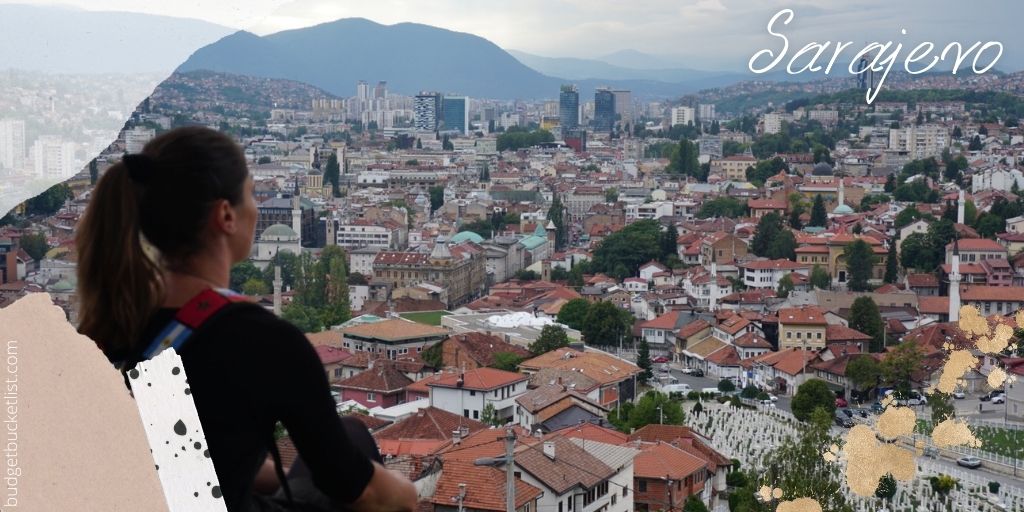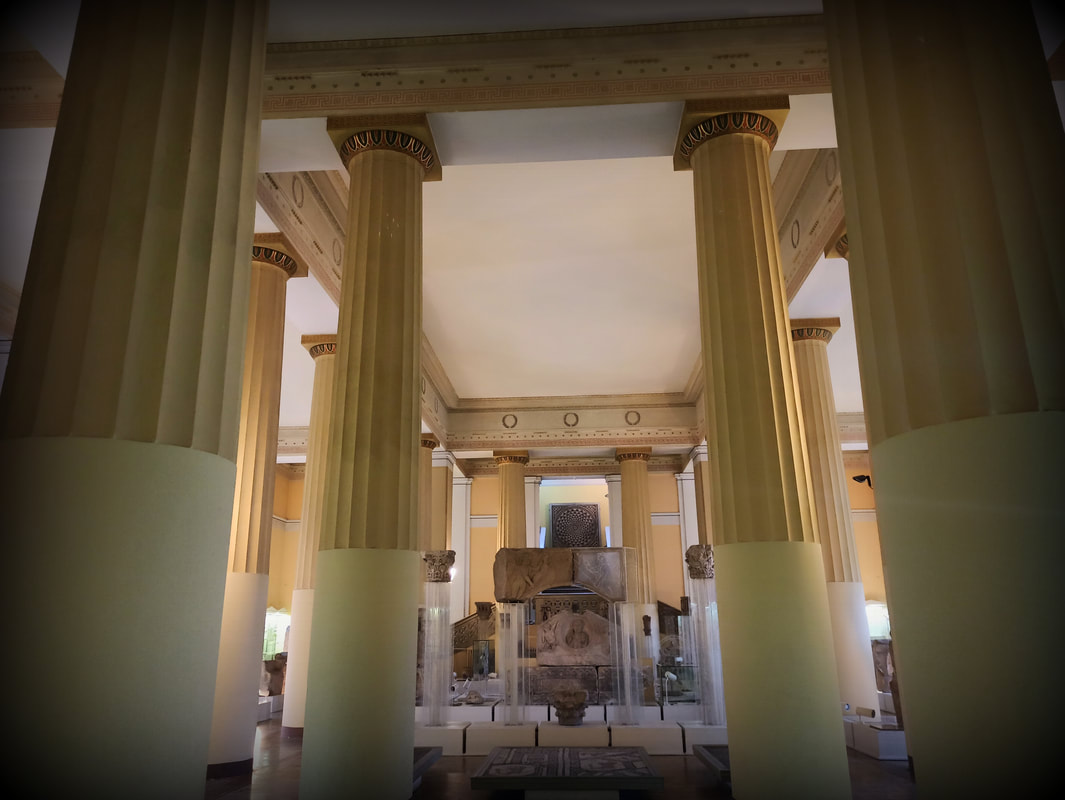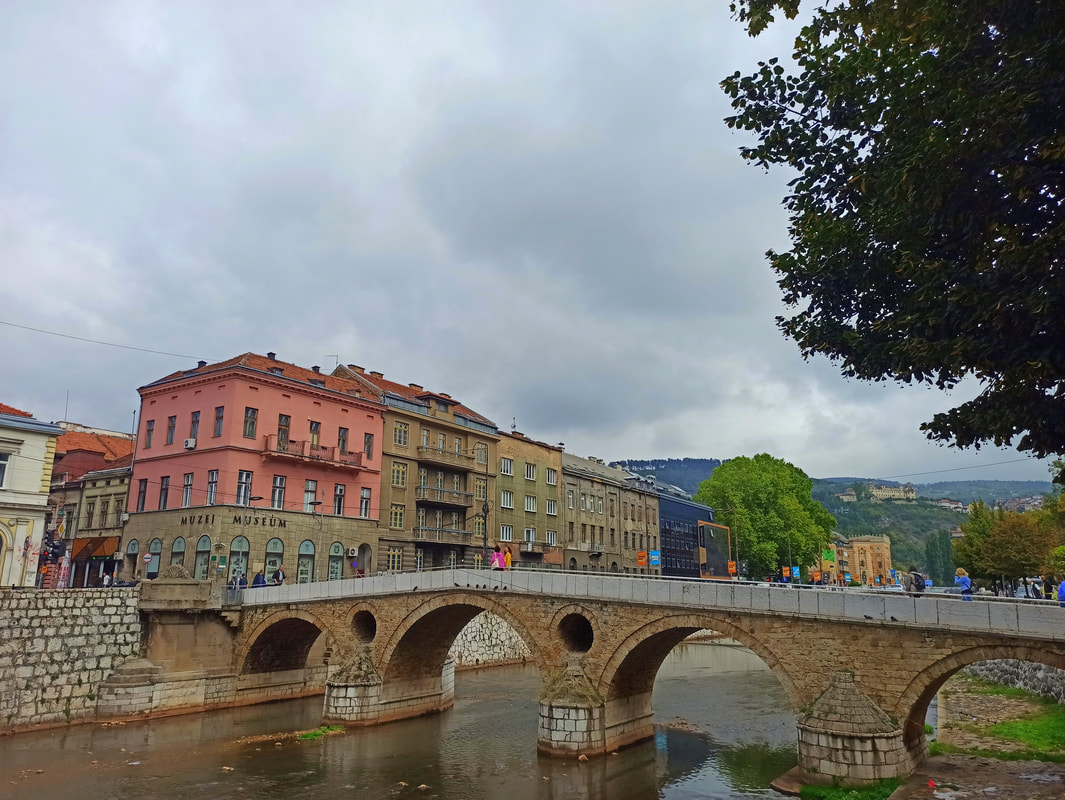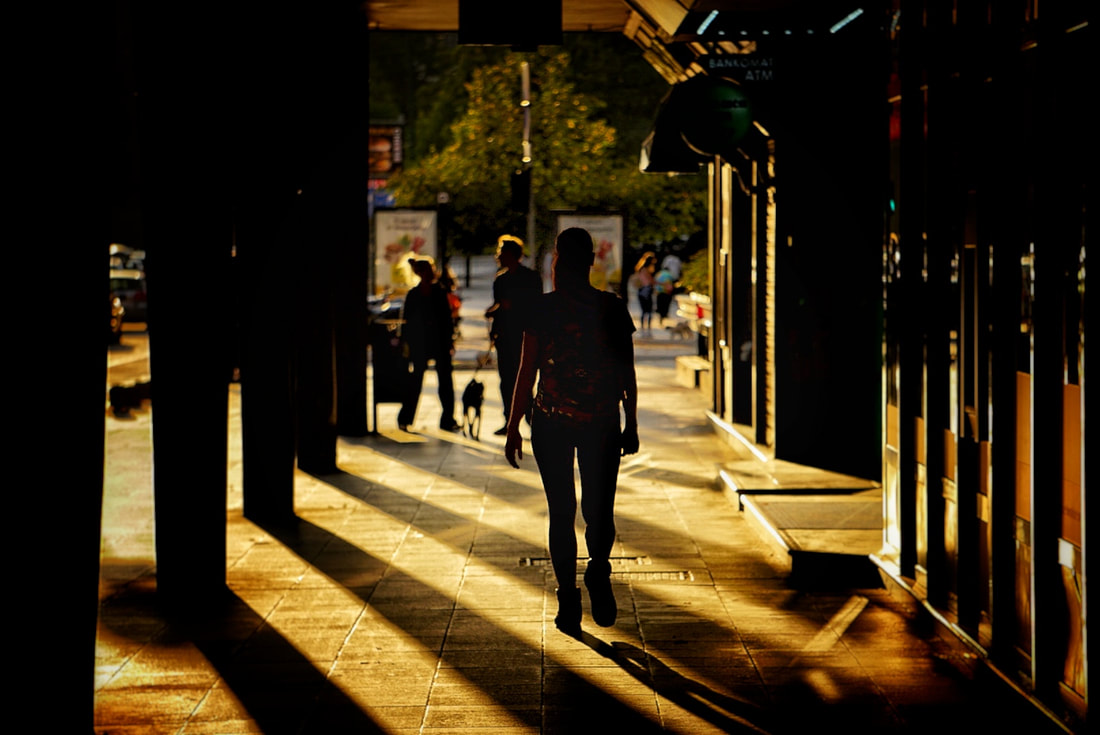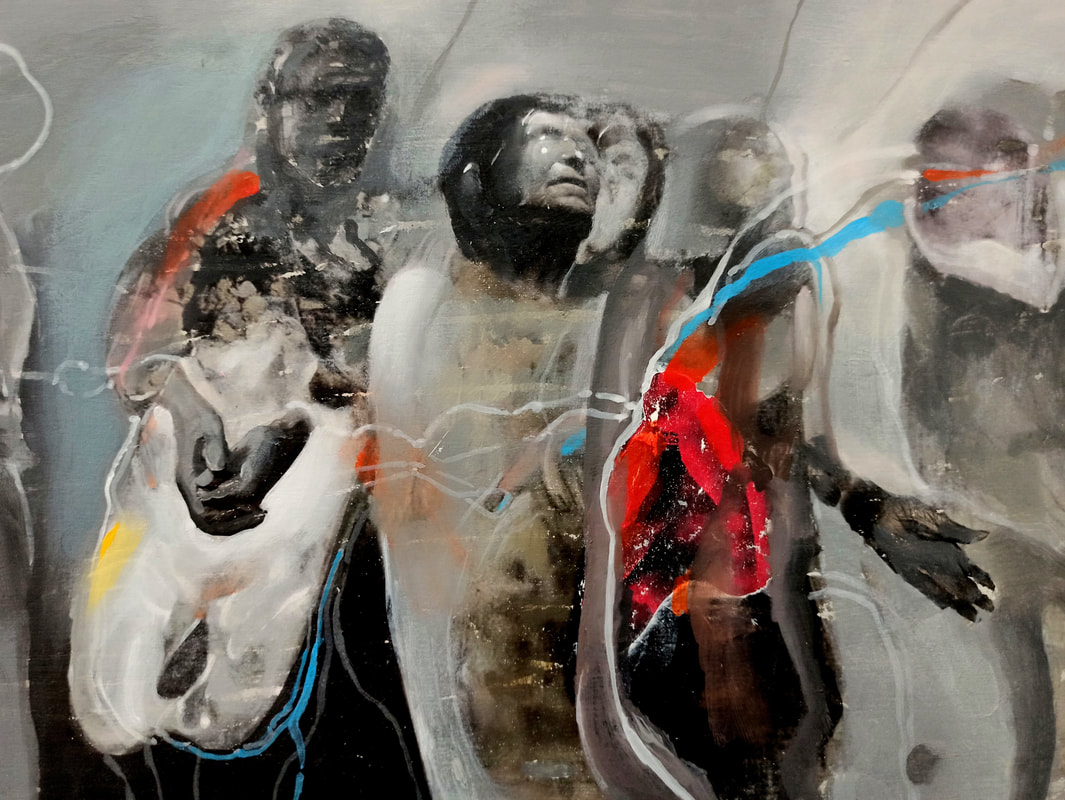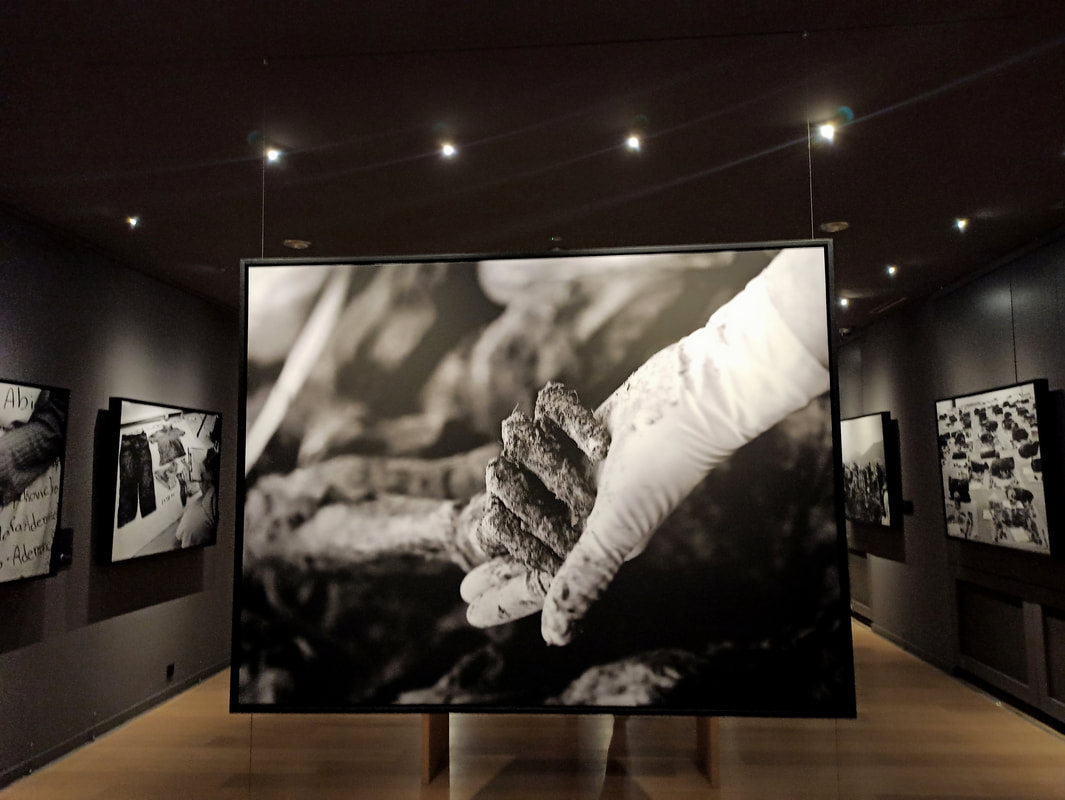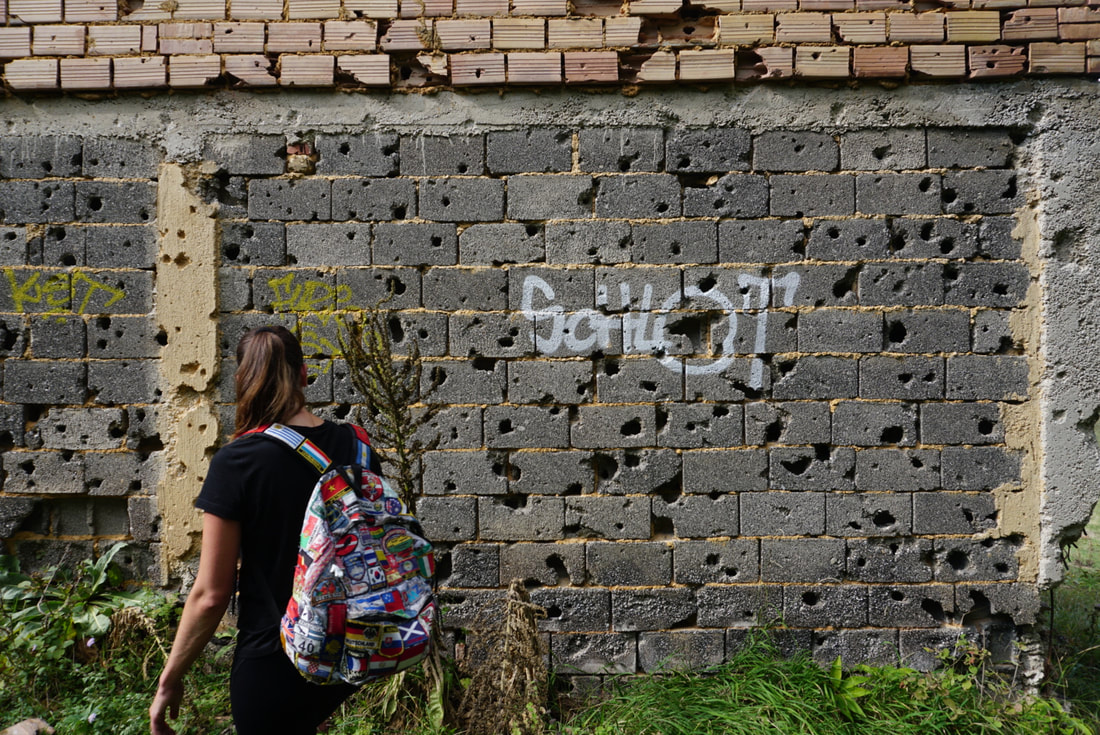Sarajevo
For budget tips & compact place-specific travel info... Download my FREE Budget Fact Sheets. You're welcome.
| Download Steph's SARAJEVO Quick Budget Fact Sheet | |
| File Size: | 281 kb |
| File Type: | |
A little quiver… A short second of mental divergence in an attempt to process a rather unusual piece of information: Every time I read "Sarajevo" on one of the road signs, it slightly bewildered me. It's a name everyone of us has heard so often, either from history books or on the news. Yet somehow, it's a bit unsettling when all of a sudden you can just be there. Walk through it. Breathe its air. Talk to people who lived there for generations.
Traveling truly is an exciting thing.
Sarajevo Then…
Walking through Sarajevo is an act of time travel. Peeling off the colorful layers of history is the only way to understand the present excitingly unfolding itself around you. This pleasant quest of self-education is best started at the National Museum*, where spread out over three big buildings you can stroll from the very beginning, the Neolithic Butmir Culture, on to the Illyrians. The latter managed to fiercely resist Roman occupation until 9BC, when Emperor Tiberius took over, which marked the initiation of Roman Rule of this region: the colony of Aquae Sulphurea. An abundant collection of artefacts, statues and pottery serve as silent witnesses to these foregone times. After subsequently the Goths and the Slavs took over, the museum leads you towards the Middle Ages and the arrival of the Ottomans, which is the main focus of the collection.
Traveling truly is an exciting thing.
Sarajevo Then…
Walking through Sarajevo is an act of time travel. Peeling off the colorful layers of history is the only way to understand the present excitingly unfolding itself around you. This pleasant quest of self-education is best started at the National Museum*, where spread out over three big buildings you can stroll from the very beginning, the Neolithic Butmir Culture, on to the Illyrians. The latter managed to fiercely resist Roman occupation until 9BC, when Emperor Tiberius took over, which marked the initiation of Roman Rule of this region: the colony of Aquae Sulphurea. An abundant collection of artefacts, statues and pottery serve as silent witnesses to these foregone times. After subsequently the Goths and the Slavs took over, the museum leads you towards the Middle Ages and the arrival of the Ottomans, which is the main focus of the collection.
* If you visit the National Museum between 6-7PM, the entry price is only KM3. If they don’t close the museum 10 minutes early (like they did in my case), this should be exactly enough time. Especially if you skip the horrifying collection of stuffed animals.
Enter Ottomans
It were in fact these Ottomans who officially founded Sarajevo in 1461. Under the lead of the first governor, Isa-Beg Ishaković, a random cluster of villages was morphed into an actual city called Bosna-Saray by providing a collection of key structures: a mosque, a bazaar, a bathing house, a hostel and a castle (in Turkish “saray” – giving Sarajevo its current name). This first mosque, the Emperor’s Mosque (Careva Džamija) can still be visited today*. And that bazaar? Yup, that’s the vibrant Baščaršija that nowadays still forms the pumping aorta of the city.
*Another historically interesting mosque is the Hadžijska Mosque, which was built to accommodate the new pilgrim-group of local Christians who had converted to Islam and were suddenly required to initiate the pilgrimage to Mecca. If you truly can’t get enough: Sarajevo, which grew out to be the second most crucial city of the Ottoman Empire besides Istanbul, is known to have a 100 mosques in total. How much time did you have planned here exactly?
Enter Ottomans
It were in fact these Ottomans who officially founded Sarajevo in 1461. Under the lead of the first governor, Isa-Beg Ishaković, a random cluster of villages was morphed into an actual city called Bosna-Saray by providing a collection of key structures: a mosque, a bazaar, a bathing house, a hostel and a castle (in Turkish “saray” – giving Sarajevo its current name). This first mosque, the Emperor’s Mosque (Careva Džamija) can still be visited today*. And that bazaar? Yup, that’s the vibrant Baščaršija that nowadays still forms the pumping aorta of the city.
*Another historically interesting mosque is the Hadžijska Mosque, which was built to accommodate the new pilgrim-group of local Christians who had converted to Islam and were suddenly required to initiate the pilgrimage to Mecca. If you truly can’t get enough: Sarajevo, which grew out to be the second most crucial city of the Ottoman Empire besides Istanbul, is known to have a 100 mosques in total. How much time did you have planned here exactly?
The Jews and the Austro-Hungarian Empire
Besides an extra whiff of influence of the Sephardic Jews, who were expelled from Spain and Portugal by the end of the 15th century and invited to resettle their population in the Ottoman Empire (and specifically in Bosna-Saraj), we can also detect some Austrian impact. That impact mainly being that (besides the earlier mentioned sights) there is very little left of the original glory days of the Ottoman Empire. Because, well… they basically sacked the city in 1697 under the flag of the Great Turkish War. After the killing and looting had been completed, they burned the city down to the ground. Oh, and left the plague as a friendly souvenir. As such, the main theme of the 1700s was rebuilding the city. However, the Austrians weren’t quite done yet. In 1878 the entire country of Bosnia and Herzegovina was occupied by the Austro-Hungarian Empire, until it was fully annexed in 1908. In this period, a thorough industrialization took place, as Sarajevo served as the guinea pig for new inventions such as tramways. Therefore, the 1879 fire that destroyed (once again) the biggest chunks of the town came in quite handy, as it created more space for redevelopment and city growth. The more modern city center bordering the Baščaršija, the “Centar” area which is now popular for its shopping and fine dining, finds its roots in this era. The border between the Centar and Baščaršija is clearly marked on the pavement. In this time period other sights of a more diverse range of styles and genres came into existence: The Sacred Heart Cathedral, the City Hall, the National Library and the Sarajevo Brewery (Sarajevska Pivara), to name a few.
Talking about Austro-Hungarian affairs in Sarajevo… Hmm yeah, that escalated quickly, on a global level. Remember that Archduke Franz Ferdinand of Austria was assassinated, the core event that triggered World War I? That took place on the Latin Bridge in downtown Sarajevo. I kid you not.
Besides an extra whiff of influence of the Sephardic Jews, who were expelled from Spain and Portugal by the end of the 15th century and invited to resettle their population in the Ottoman Empire (and specifically in Bosna-Saraj), we can also detect some Austrian impact. That impact mainly being that (besides the earlier mentioned sights) there is very little left of the original glory days of the Ottoman Empire. Because, well… they basically sacked the city in 1697 under the flag of the Great Turkish War. After the killing and looting had been completed, they burned the city down to the ground. Oh, and left the plague as a friendly souvenir. As such, the main theme of the 1700s was rebuilding the city. However, the Austrians weren’t quite done yet. In 1878 the entire country of Bosnia and Herzegovina was occupied by the Austro-Hungarian Empire, until it was fully annexed in 1908. In this period, a thorough industrialization took place, as Sarajevo served as the guinea pig for new inventions such as tramways. Therefore, the 1879 fire that destroyed (once again) the biggest chunks of the town came in quite handy, as it created more space for redevelopment and city growth. The more modern city center bordering the Baščaršija, the “Centar” area which is now popular for its shopping and fine dining, finds its roots in this era. The border between the Centar and Baščaršija is clearly marked on the pavement. In this time period other sights of a more diverse range of styles and genres came into existence: The Sacred Heart Cathedral, the City Hall, the National Library and the Sarajevo Brewery (Sarajevska Pivara), to name a few.
Talking about Austro-Hungarian affairs in Sarajevo… Hmm yeah, that escalated quickly, on a global level. Remember that Archduke Franz Ferdinand of Austria was assassinated, the core event that triggered World War I? That took place on the Latin Bridge in downtown Sarajevo. I kid you not.
I still can’t believe my accommodation was just a stone’s throw away from the Franz Ferdinand Bridge. Sarajevo: What an unreal place to be in! More info on this topic can be obtained in the Museum of Sarajevo 1878-1918.
WWI & WWII
WWI raged on for another 4 years until the Allies turned it into their victory (crushing the Central Powers incl. Austria-Hungary). One of the outcomes of the war was the adaption of Bosnia and Herzegovina into the Kingdom of the Serbs, Croats and Slovenes… a monarchy which changed its name to the Kingdom of Yugoslavia in 1929. A year later, the Art Gallery was established, which can still be visited today. This museum introduced me to the work of the talented local Bosnian artist Marko Kusmuk, for which I am grateful.
In 1939, when WWII broke out in Europe, the area was entirely overrun by German and Italian Nazi/Fascist forces (one of the reasons the older generation in this country often speaks basic German). Needless to say, this led to the destruction of many iconic synagogues, in a bigger perspective of an insusceptible tragedy for the Jewish community… no less than 85% of the local Jewish population was deported to their deaths in Croatian concentration camps. A remaining synagogue that can still be admired today is the Ashkenazi. The Jewish Museum elaborates further on the detailed history of the Bosnian Jews.
Simultaneously with the Holocaust, another event taking place during WWII was the Genocide of Serbs carried out by Croatian Nationalists considering the Serbs an inferior race. This brutal ethnic cleansing took place in the Nazi German puppet state known as the Independent State of Croatia. In 1941 a group of notable Bosniaks (Muslims) of Sarajevo openly condemned this practice, causing around 20,000 Serbs to seek refuge in this city. The St. Michael the Archangel is a Serbian Orthodox Church worth visiting, at a stone’s throw away from the Baščaršija.
Sarajevo was liberated from the Nazis on April 6th, 1945. The 78,000-square-meters Vraca Memorial Park serves as a monument to all WWII victims.
WWI & WWII
WWI raged on for another 4 years until the Allies turned it into their victory (crushing the Central Powers incl. Austria-Hungary). One of the outcomes of the war was the adaption of Bosnia and Herzegovina into the Kingdom of the Serbs, Croats and Slovenes… a monarchy which changed its name to the Kingdom of Yugoslavia in 1929. A year later, the Art Gallery was established, which can still be visited today. This museum introduced me to the work of the talented local Bosnian artist Marko Kusmuk, for which I am grateful.
In 1939, when WWII broke out in Europe, the area was entirely overrun by German and Italian Nazi/Fascist forces (one of the reasons the older generation in this country often speaks basic German). Needless to say, this led to the destruction of many iconic synagogues, in a bigger perspective of an insusceptible tragedy for the Jewish community… no less than 85% of the local Jewish population was deported to their deaths in Croatian concentration camps. A remaining synagogue that can still be admired today is the Ashkenazi. The Jewish Museum elaborates further on the detailed history of the Bosnian Jews.
Simultaneously with the Holocaust, another event taking place during WWII was the Genocide of Serbs carried out by Croatian Nationalists considering the Serbs an inferior race. This brutal ethnic cleansing took place in the Nazi German puppet state known as the Independent State of Croatia. In 1941 a group of notable Bosniaks (Muslims) of Sarajevo openly condemned this practice, causing around 20,000 Serbs to seek refuge in this city. The St. Michael the Archangel is a Serbian Orthodox Church worth visiting, at a stone’s throw away from the Baščaršija.
Sarajevo was liberated from the Nazis on April 6th, 1945. The 78,000-square-meters Vraca Memorial Park serves as a monument to all WWII victims.
|
The opening- and closing photo, as well as this photo (left) are shot by photographer Miles Watson.
|
Communist Yugoslavia
Post-war, Bosnia and Herzegovina was turned into one of the 6 states of the Social Federal Republic of Yugoslavia. In Sarajevo communist residential blocks were erected in the municipalities Novi Grad and Novo Sarajevo, sheltering the city’s rapidly rising population. A key event during Yugoslavian times were the 1984 Winter Olympics, the first one of the kind to be held in a Slavic, Socialist State and the first one in the Balkans since the very first event in Athens. This affair caused a tourism boom in Sarajevo and marked the beginning of one of the most prosperous episodes of the city. The most unusual experience during any Sarajevo-visit is the hike up and over the now entirely abandoned bobsleigh track. It’s an odd landmark combining history and faded glory. The track is marked by traces of the Bosnian War, colorful graffiti and the power of nature slowly but decisively taking over again. On the short but steep way up (come on, you’re not gonna take that lazy cable car), stop at the Colina Kapa Viewpoint next to bullet-ridden sniper towers*. Another Olympic-themed sight is the Olympic Stadium at the other side of town… once a place of excitement and happiness, but later a monument of tragedy during the Bosnian War. As the existing Islamic cemeteries didn't have sufficient place for the steep number of murdered Bosniaks, and mourning family members were shot during the funeral services of their loved ones, the Olympic Stadium was turned into an improvised graveyard.
* Other great viewpoints are Žuta Tabija and Crvena Tabija.
Post-war, Bosnia and Herzegovina was turned into one of the 6 states of the Social Federal Republic of Yugoslavia. In Sarajevo communist residential blocks were erected in the municipalities Novi Grad and Novo Sarajevo, sheltering the city’s rapidly rising population. A key event during Yugoslavian times were the 1984 Winter Olympics, the first one of the kind to be held in a Slavic, Socialist State and the first one in the Balkans since the very first event in Athens. This affair caused a tourism boom in Sarajevo and marked the beginning of one of the most prosperous episodes of the city. The most unusual experience during any Sarajevo-visit is the hike up and over the now entirely abandoned bobsleigh track. It’s an odd landmark combining history and faded glory. The track is marked by traces of the Bosnian War, colorful graffiti and the power of nature slowly but decisively taking over again. On the short but steep way up (come on, you’re not gonna take that lazy cable car), stop at the Colina Kapa Viewpoint next to bullet-ridden sniper towers*. Another Olympic-themed sight is the Olympic Stadium at the other side of town… once a place of excitement and happiness, but later a monument of tragedy during the Bosnian War. As the existing Islamic cemeteries didn't have sufficient place for the steep number of murdered Bosniaks, and mourning family members were shot during the funeral services of their loved ones, the Olympic Stadium was turned into an improvised graveyard.
* Other great viewpoints are Žuta Tabija and Crvena Tabija.
Bosnian War
Yes, the Bosnian War. The one that put Sarajevo on the map (in the most unfortunate manner) for our generation, as we were alive to see those heart-breaking images on the news. So, what happened? United Yugoslavia started to crumble, related to a rapid economic decline. While Serbia tried to keep Yugoslavia together, Slovenia and Croatia declared independence in 1991 with UN recognition (resulting in the Ten-Day-War and the Croatian War of Independence)… and Bosnia and Herzegovina was suggested to do the same. However, the multi-ethnicity in Bosnia and Herzegovina adds an extra layer to this already tense situation. The country exists of 3 predominant population groups: Serbian Bosnians, Croatian Bosnians and Bosniaks (Muslims, but during the prohibition of religion in communist times referred to as an ethnic group, not as a religious classification). At the time, the Bosniaks accounted for the biggest group of all. Politically, the division of these 3 groups became more visible, together with a manipulated enforcement of nationalistic sentiments. The Croats and Bosniaks were in favor of independence, while the Bosnian Serbs wanted certain regions promptly declared as "Republika Srpska" to be part of greater Serbia (this included Sarajevo).
The Bosnian Serbs drew the shortest straw when the United States and the European Commission officially recognized the independence of Bosnia and Herzegovina, including the areas of Republika Srpska. To say they didn’t agree is an understatement. Sarajevo was immediately besieged by a Serbia-backed Republika Srpska Army targeting both the Croats and Bosniaks. This was the mere start of a brutal ethnical cleansing eventually killing 11,541 people (incl. 1,500 children) and wounding another 56,000. To get an idea of the disturbing nature of the war crimes, I invite you to read some of the stories in the photos below. Initially the UN refused to intervene, but when they finally did, they failed to actually protect the UN-declared “safe areas”, resulting in the Srebrenica massacre demanding the lives of 7000 Bosniak men. This event however caused the NATO to organize more concentrated air strike attacks, which, combined with a large-scale Bosniak-Croat land offensive, pushed the Bosnian Serbs into the US-backed Dayton Peace Talks which eventually ended 3.5 years of war. Bosnia and Herzegovina became a separate country divided into the "Federation of Bosnia and Herzegovina" (predominantly Bosniaks and Croats) and "Republika Srpska" (mainly Bosnian Serbs). Sarajevo belongs to the first entity.
Yes, the Bosnian War. The one that put Sarajevo on the map (in the most unfortunate manner) for our generation, as we were alive to see those heart-breaking images on the news. So, what happened? United Yugoslavia started to crumble, related to a rapid economic decline. While Serbia tried to keep Yugoslavia together, Slovenia and Croatia declared independence in 1991 with UN recognition (resulting in the Ten-Day-War and the Croatian War of Independence)… and Bosnia and Herzegovina was suggested to do the same. However, the multi-ethnicity in Bosnia and Herzegovina adds an extra layer to this already tense situation. The country exists of 3 predominant population groups: Serbian Bosnians, Croatian Bosnians and Bosniaks (Muslims, but during the prohibition of religion in communist times referred to as an ethnic group, not as a religious classification). At the time, the Bosniaks accounted for the biggest group of all. Politically, the division of these 3 groups became more visible, together with a manipulated enforcement of nationalistic sentiments. The Croats and Bosniaks were in favor of independence, while the Bosnian Serbs wanted certain regions promptly declared as "Republika Srpska" to be part of greater Serbia (this included Sarajevo).
The Bosnian Serbs drew the shortest straw when the United States and the European Commission officially recognized the independence of Bosnia and Herzegovina, including the areas of Republika Srpska. To say they didn’t agree is an understatement. Sarajevo was immediately besieged by a Serbia-backed Republika Srpska Army targeting both the Croats and Bosniaks. This was the mere start of a brutal ethnical cleansing eventually killing 11,541 people (incl. 1,500 children) and wounding another 56,000. To get an idea of the disturbing nature of the war crimes, I invite you to read some of the stories in the photos below. Initially the UN refused to intervene, but when they finally did, they failed to actually protect the UN-declared “safe areas”, resulting in the Srebrenica massacre demanding the lives of 7000 Bosniak men. This event however caused the NATO to organize more concentrated air strike attacks, which, combined with a large-scale Bosniak-Croat land offensive, pushed the Bosnian Serbs into the US-backed Dayton Peace Talks which eventually ended 3.5 years of war. Bosnia and Herzegovina became a separate country divided into the "Federation of Bosnia and Herzegovina" (predominantly Bosniaks and Croats) and "Republika Srpska" (mainly Bosnian Serbs). Sarajevo belongs to the first entity.
You can pause the photo presentation and enlarge the screen to properly read the stories.
As the most recent war that has affected the majority of its current citizens, it most visibly marks the city. Marked not only in terms of buildings not yet restored from sniper fire and shrapnel, but by sights and museums dedicated to this specific part of history. Because there are quite a handful of them, I personally selected the Gallery 11/07/95 (photo museum focused on the Srebrenica massacre) and the Museum of Crimes Against Humanity for a visit. I cried in the latter. Reading the dark stories of torture, rape and other severe violations of human rights in excruciating detail isn’t an easy thing to mentally process… let alone to execute towards another human-being. How this could ever happen, here or elsewhere in the world, goes beyond my understanding. Another interesting visit, be it about an hour outside of the centre, is to the Tunnel Museum*. This perfectly preserved tunnel, nicknamed the Tunnel of Hope, was the only way in and out of Sarajevo when it was besieged and cut off by Serbian forces. This gateway allowed food, commodities, war supplies, humanitarian aid and soldiers to get into the city, as well as providing a means of escape for its citizens. In short, the mere existence of this tunnel saved an incomprehensible amount of lives and simply standing at this very spot is hard to take in.
For a more thorough understanding of the Siege of Sarajevo, I strongly recommend the tip-based War Scars & New Times Free Walking Tour by Neno & Friends. Standard stops are the Presidency and Parliament Building ; the notorious Sniper Alley targeting Sarajevo’s main road; the Holiday Inn Hotel were all international journalists covering the war resided; the Children Memorial made of melted scraps of attacks specifically targeted to schools and hospitals; and the Markale Market where an exploded missile caused 67 deaths in one go. The tour, or any random walk through Sarajevo, leads passed the many Sarajevo Roses… holes of exploded missiles filled up with red resin, serving as silent memorials of the ones that lost their lives at that specific spot. Walking over it almost feels like blasphemy and I couldn’t get myself to do it. This interactive and engaging tour gives you the opportunity to ask direct questions to a guide who actually lived to tell the story, while alternating heart-breaking tales with bitter-sweet anecdotes (for example: apparently current Sarajevo citizens joke about always being missed by someone… referring to the snipers that didn’t kill them).
* To reach the Tunnel Museum: Take Tram 3, 4 or 6 until Llidza, and then bus 32 to Branilaca Donjeg Kotorca. FYI: Google Maps gives ridiculous public transport routes, Moovit is more reliable in Sarajevo.
As the most recent war that has affected the majority of its current citizens, it most visibly marks the city. Marked not only in terms of buildings not yet restored from sniper fire and shrapnel, but by sights and museums dedicated to this specific part of history. Because there are quite a handful of them, I personally selected the Gallery 11/07/95 (photo museum focused on the Srebrenica massacre) and the Museum of Crimes Against Humanity for a visit. I cried in the latter. Reading the dark stories of torture, rape and other severe violations of human rights in excruciating detail isn’t an easy thing to mentally process… let alone to execute towards another human-being. How this could ever happen, here or elsewhere in the world, goes beyond my understanding. Another interesting visit, be it about an hour outside of the centre, is to the Tunnel Museum*. This perfectly preserved tunnel, nicknamed the Tunnel of Hope, was the only way in and out of Sarajevo when it was besieged and cut off by Serbian forces. This gateway allowed food, commodities, war supplies, humanitarian aid and soldiers to get into the city, as well as providing a means of escape for its citizens. In short, the mere existence of this tunnel saved an incomprehensible amount of lives and simply standing at this very spot is hard to take in.
For a more thorough understanding of the Siege of Sarajevo, I strongly recommend the tip-based War Scars & New Times Free Walking Tour by Neno & Friends. Standard stops are the Presidency and Parliament Building ; the notorious Sniper Alley targeting Sarajevo’s main road; the Holiday Inn Hotel were all international journalists covering the war resided; the Children Memorial made of melted scraps of attacks specifically targeted to schools and hospitals; and the Markale Market where an exploded missile caused 67 deaths in one go. The tour, or any random walk through Sarajevo, leads passed the many Sarajevo Roses… holes of exploded missiles filled up with red resin, serving as silent memorials of the ones that lost their lives at that specific spot. Walking over it almost feels like blasphemy and I couldn’t get myself to do it. This interactive and engaging tour gives you the opportunity to ask direct questions to a guide who actually lived to tell the story, while alternating heart-breaking tales with bitter-sweet anecdotes (for example: apparently current Sarajevo citizens joke about always being missed by someone… referring to the snipers that didn’t kill them).
* To reach the Tunnel Museum: Take Tram 3, 4 or 6 until Llidza, and then bus 32 to Branilaca Donjeg Kotorca. FYI: Google Maps gives ridiculous public transport routes, Moovit is more reliable in Sarajevo.
After the Bosnian War, new mosques were inaugurated: King Fahd Mosque, Istiglal Mosque, and Baitus Salam Mosque. In 2008, the Avaz Twist Tower enriched Sarajevo’s skyline.
Sarajevo Now…
Finally, after a long history of wars and struggle, apparent peace has returned. It truly is a serene spectacle… sitting on a bench in the middle of Sarajevo, watching the stunning variety of people parade by, powerfully expressing the colorful concept of a “melting pot”. Baklava with cevapi, church bells blending in with imam chants and songs of gypsies. The interaction of cultures turns Sarajevo into a journey instead of a simple destination. Never have I been so tempted to feel a city. To become one of the many colorful elements which brings Sarajevo to life.
A façade, perhaps. As underneath this exciting display the 2-sided division is still going strong resulting in visible and marked borders within the country, and the 3 ethnicities loud and clearly identifying as separate entities. The country is confusingly led by 3 different presidents (1 from the Federation of Bosnia and Herzegovina, 1 from Republika Srpska, and 1 external) and you can only vote for a candidate of “your group.” Even if you wanted to integrate and become one, politically you are immediately pushed back “where you belong”. A forced deal of co-existence preserving peace, or a stubborn system focused on separation inevitably sparking up future nationalism? Time will tell. Sarajevo is the bright poster boy of the famous phrase “never again”… and let’s hope that is indeed the case.
Sarajevo Now…
Finally, after a long history of wars and struggle, apparent peace has returned. It truly is a serene spectacle… sitting on a bench in the middle of Sarajevo, watching the stunning variety of people parade by, powerfully expressing the colorful concept of a “melting pot”. Baklava with cevapi, church bells blending in with imam chants and songs of gypsies. The interaction of cultures turns Sarajevo into a journey instead of a simple destination. Never have I been so tempted to feel a city. To become one of the many colorful elements which brings Sarajevo to life.
A façade, perhaps. As underneath this exciting display the 2-sided division is still going strong resulting in visible and marked borders within the country, and the 3 ethnicities loud and clearly identifying as separate entities. The country is confusingly led by 3 different presidents (1 from the Federation of Bosnia and Herzegovina, 1 from Republika Srpska, and 1 external) and you can only vote for a candidate of “your group.” Even if you wanted to integrate and become one, politically you are immediately pushed back “where you belong”. A forced deal of co-existence preserving peace, or a stubborn system focused on separation inevitably sparking up future nationalism? Time will tell. Sarajevo is the bright poster boy of the famous phrase “never again”… and let’s hope that is indeed the case.
In order to support the travelers’ community, I spend many hours per week to adequately document all information and advices for prospective visitors, accompanied by a (hopefully) entertaining insight into my personal observations and experiences. This service is and will remain free. However, if you voluntarily want to make a contribution and support my travels and thus the creation of new stories and information supply, here is the button you’re looking for:
Related:
- Read more about Bosnia & Herzegovina: Mostar, Blagaj, Trebinje, Jajce, Banja Luka and Sutjeska National Park (incl. Maglic Peak - the country's highest!)
- Budget Bucket List hitchhike trip to... Kosovo!
- Guest Blog 'Kosovo Girl Travels': Travel tips and stories from Kosovo's first and only travelblogger!
- Destinations of Hungary: Balaton Lake, Budapest and Szekesfehervar
- Visit Balkan's finest: Montenegro's National Parks Blog, Kotor Bay & Lovcen NP and Cetinje, Durmitor NP, Podgorica, Prokletije NP and Montenegro's Coastal Towns Blog
- Get your Albania itinerary ready: Berat, Gjirokastër, Korcë / Ohrid Lake, Theth, Shkodër, Tirana, Mount Korab & the coast!
- Citytripping in Denmark's capital: Copenhagen
- Discover Romania's enjoyable cities: Bucharest, Brasov and Cluj Napoca
- Be about Bulgaria: Check off Bansko, Belogradchik, Plovdiv, Sofia and of course Veliko Tarnovo!
- Get deep into Greece: Athens, Delphi, Arachova, Mount Parnassos NP, Epirus, Meteora, Thessaloniki & Volos
- Archeological treasures, UNESCO sights and Greece's roughest nature: Explore the Peloponnese!
- Where modern meets classic: Vilnius, Lithuania
- 8 ways to save money in Vienna, Austria
- German gems: Aachen & Frankfurt am Main
- A capital surrounded by scenic little villages: Lisbon, Portugal
- Discover more Belgium: Antwerp & the most kick-ass Flanders itinerary!
- Where city and nature meet: Edinburgh, Scotland
- Unravel the mysteries of Serbia
- Spanish citytrips: Barcelona, Malaga & Sevilla
- Discover the splendours of Turkey: Istanbul on a Budget & Reasons to visit Edirne
- Read more about Bosnia & Herzegovina: Mostar, Blagaj, Trebinje, Jajce, Banja Luka and Sutjeska National Park (incl. Maglic Peak - the country's highest!)
- Budget Bucket List hitchhike trip to... Kosovo!
- Guest Blog 'Kosovo Girl Travels': Travel tips and stories from Kosovo's first and only travelblogger!
- Destinations of Hungary: Balaton Lake, Budapest and Szekesfehervar
- Visit Balkan's finest: Montenegro's National Parks Blog, Kotor Bay & Lovcen NP and Cetinje, Durmitor NP, Podgorica, Prokletije NP and Montenegro's Coastal Towns Blog
- Get your Albania itinerary ready: Berat, Gjirokastër, Korcë / Ohrid Lake, Theth, Shkodër, Tirana, Mount Korab & the coast!
- Citytripping in Denmark's capital: Copenhagen
- Discover Romania's enjoyable cities: Bucharest, Brasov and Cluj Napoca
- Be about Bulgaria: Check off Bansko, Belogradchik, Plovdiv, Sofia and of course Veliko Tarnovo!
- Get deep into Greece: Athens, Delphi, Arachova, Mount Parnassos NP, Epirus, Meteora, Thessaloniki & Volos
- Archeological treasures, UNESCO sights and Greece's roughest nature: Explore the Peloponnese!
- Where modern meets classic: Vilnius, Lithuania
- 8 ways to save money in Vienna, Austria
- German gems: Aachen & Frankfurt am Main
- A capital surrounded by scenic little villages: Lisbon, Portugal
- Discover more Belgium: Antwerp & the most kick-ass Flanders itinerary!
- Where city and nature meet: Edinburgh, Scotland
- Unravel the mysteries of Serbia
- Spanish citytrips: Barcelona, Malaga & Sevilla
- Discover the splendours of Turkey: Istanbul on a Budget & Reasons to visit Edirne
